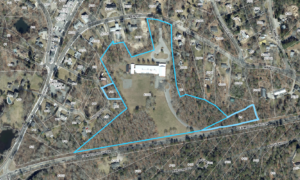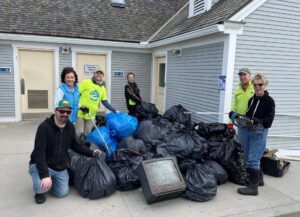 HYANNIS – A local environmental organization is concerned that an Environmental Protection Agency plan for highly toxic chemicals in groundwater lacks proper action.
HYANNIS – A local environmental organization is concerned that an Environmental Protection Agency plan for highly toxic chemicals in groundwater lacks proper action.
The PFAS chemicals, which are found in firefighting foam, nonstick coatings, water-repellent clothing and many other household and personal items have been linked to health threats ranging from cancer to decreased fertility.
The PFAS Action Plan, unveiled last week, will move forward with setting maximum contaminant levels, continuing enforcement actions, expanding environmental monitoring, enhancing research, and developing new analytical methods and tools.
GreenCape, the Cape Alliance for Pesticide Education, works to increase public awareness of the risks of pesticides and other chemicals to health and the vulnerability of the Cape Cod water supply.
The organization and the National PFAS Contamination Coalition say the plan is woefully inadequate for individuals and communities that have suffered from expose to contamination for many years.
“It is just a plan that does not appear to have an action piece,” said Sue Phelan, the leader of GreenCape.
Phelan said the organization talked with Alexandra Dunn, the assistant administrator of EPA’s Office of Chemical Safety and Pollution Prevention, last year and felt the agency would move solutions ahead more quickly.
“While there seems to be more press, it doesn’t seem to be a lot of action,” Phelan said.
Phelan said there is concern that EPA has yet to established a Maximum Contaminant Level for PFAS chemicals in groundwater.
“There’s no establishment of any of the PFAS’s as hazardous substances which would really be the method to kick in a lot of money for cleanup,” Phelan said.
Phelan said the organization doesn’t have much faith in the federal agency and believes more will get done at the state level to resolve contaminant issues.
“We are having talks with the Department of Environmental Protection and the Executive Office of Energy and Environmental Affairs and we have been doing that for the past year,” Phelan said.
Phelan said state environmental officials understand the seriousness of the issue.
She expects the DEP to make an announcement soon following a recent petition hearing.
“I’m just keeping my fingers crossed that it’s going to have three letters in it – MCL – Maximum Contaminants Level,” Phelan said. “That’s going to be so helpful to everybody.”
The issue of the contaminants in local groundwater has been a concern in recent years.
Silent Spring Institute recently launched a wide-scale study into water contaminants related to PFAS.
The PFAS REACH study, which stands for Research, Education and Action for Community Help, will focus on highly fluorinated chemicals in the Hyannis water system.
The Hyannis water system has been impacted by the contaminants, mostly from the use of firefighting foams at the Barnstable Fire Training Academy and Barnstable Municipal Airport.
A component of the initiative will be to study potential immune system effects from the contaminants in children.
Previous research by a Harvard researcher has suggested children have more exposure to these chemicals and may have less of an immune system boost after they get vaccinations.
Officials with the Town of Barnstable have met with the Massachusetts Department of Fish and Wildlife to discuss the potential of siting new water supply wells on state land.
The talks follow contamination concerns at previous well locations.
Hyannis water is currently being treated for these contaminants.
On Martha’s Vineyard, airport officials have been testing residential wells in the area for possible contamination after the discovery of PFAS chemicals believed to be from the use of firefighting foam.
A testing company determined that 13 wells among 96 tested were positive for elevated levels of the contaminant and six posed an immediate health hazard.
The tests were conducted in January, most of the contamination was found in locations south of the airport.
To mitigate the problem, the Airport is installing and monitoring filtration equipment that reduces the amount of PFS in the water. The systems cost about $4,000 each. Officials on the Island are still trying to determine if the contamination may have reached the Island aquifer.
The EPA’s plan is made up of five critical elements.
The first is to take steps to address drinking water by moving forward with the Maximum Contaminant Level process outlined in the Safe Drinking Water Act for PFOA and PFOS – the two most well-known and prevalent PFAS chemicals.
“By the end of this year the EPA will propose a regulatory determination which is the next step legally required under the Safe Drinking Water Act for establishing an MCL,” Dunn said.
The EPA is also gathering and evaluating information to determine if regulation under the Safe Drinking Water Act is appropriate for other chemicals in the PFAS family.
The plan also continues enforcement actions and clarifies the EPA’s clean up strategies.
To date, the EPA has addressed and issued direct enforcement orders or assisted our states with enforcement actions in eight separate instances.
“We are also coordinating with the Department of Defense and the effected community at a former Army facility right here in the Commonwealth regarding a DOD action to protect the community’s drinking water from PFAS releases,” Dunn said.
EPA has also begun the regulatory development process for listing PFOA and PFOS as hazardous substances under the Superfund Statute.
“This important work will provide additional tools to help states and communities address existing contamination and recover costs from responsible parties,” Dunn.
The third step is expanding PFAS monitoring and the understanding of the chemicals in the environment.
EPA will propose to include PFAS in the next round of nationwide drinking water monitoring under the Unregulated Contaminant Monitoring Program.
“In the previous round of monitoring that we did EPA found 1.3 percent of public water systems had at least one sample with PFOA and PFOS,” Dunn said. “We want to look again and we will continue to look again in the next round of monitoring.”
The EPA has also been asked by stakeholders to add PFAS chemicals to the Toxic Release Inventory.
“These actions are especially important because they provide the agency with even more information on where PFAS is found in the environment,” Dunn said.
The fourth step in the plan is expanding research efforts to have a more solid scientific foundation for addressing PFAS by developing new analytical methods and tools.
The research agenda focuses on four key areas.
- What are the human health and ecological effects of exposure to PFAS?
- What are the significant sources and transport pathways in exposures to humans and ecosystems?
- What are the costs and effectiveness of different methods for removing and remediating PFAS in the natural and built environment?
- How can EPA support stakeholders using science to protect public health and the environment?
“Our goal is to close the gap on the science as quickly as possible, especially as it relates to other emerging risks,” Dunn said.
EPA is also working to develop new technologies and treatment options to remove PFAS from drinking water.
The final step is working across the agency and the federal government to develop a PFAS risk communication tool box.
It includes materials that states, tribes and local partners can use to talk about these issues with the public.
“We owe it to the public to be able to explain, in simple and easy terms, what are the risks they face in their daily lives,” Dunn said.
Dunn said the action plan commits EPA to take important steps in how we research, monitor, detect and address PFAS.























